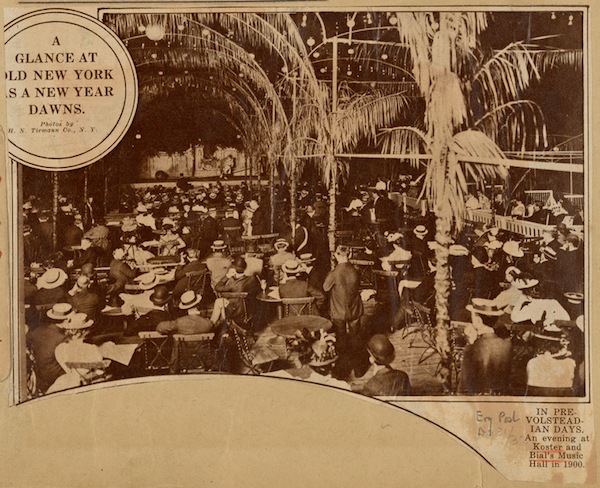
BY TRAV S.D. | For Women’s History Month, we will continue our series on famous vaudeville performers connected with the Tenderloin District. Now long defunct, the Tenderloin was a NYC neighborhood that at its furthest extent ran between 24th and 62nd Streets between 5th and 8th Avenues, thus overlapping with modern Chelsea. The Tenderloin was so-named by a local police captain who relished the nabe for its savory graft. In its heyday of the 1880s through the early 1910s, it was a nightlife mecca full of saloons, dance halls, gambling dens, and bordellos. This month, we will focus on female stars connected with Koster and Bial’s Music Hall, which was located at the present day site of Macy’s Department Store. Koster and Bial’s had the unique distinction of being both posh and somewhat disreputable, presenting entertainment similar in spirit to burlesque at the height of the Victorian era.
One of America’s first women of color to become a national stage star of historic import got her start at Koster and Bial’s. Aida Overton Walker (1880-1914) was a singer, dancer, actor, choreographer, comedienne, and “Queen of the Cakewalk.”
Born Ada Overton (she later embellished the spelling for professional reasons) in Greenwich Village, Overton was the daughter of a waiter and a seamstress. Her dancing talent was so evident from a young age that her parents provided her with formal training. She was only 15 when she joined John Isham’s Octoroons, an all-black minstrel show in 1895. In 1896-97 she was a member of the legendary Black Patti’s Troubadors, led by Sissieretta Jones, who was known professionally as the Black Patti, a reference to opera singer Adelina Patti.
In 1898, the comely chorine answered a call to model for an advertisement for Williams and Walker vaudeville revue at Koster and Bial’s. This led to her joining the show in the chorus, which then led to her being a featured performer with her partner Grace Halliday. Overton and Halliday performed as the Honolulu Belles in the first of the Williams and Walker musicals The Policy Players (1899), also at Koster and Bial’s.
That year, she also married George Walker and attained star status in the company, essentially becoming a third partner in the most celebrated African American act of the era. Overton was to choreograph all the Williams and Walker shows, as well as Cole and Johnson’s 1911 show Red Moon. The Walkers became the most celebrated cakewalking couple in the country.
Overton was to gain inroads into white society by teaching the dance at private functions. Meanwhile, she was in the process of becoming the top female African American stage performer of her day. In The Sons of Ham (1900), she made a hit with “Miss Hannah from Savanna.” In Dahomey (1902) was the show that turned the decades-old cakewalk into a dance craze with whites as well; it toured as far as London, where the company gave a Command Performance for King Edward VII. Next came Abyssinia (1905) and Bandanna Land (1907). The latter show featured Overton’s tasteful, refined take on the Salome dance craze then sweeping the nation.
In 1909 George Walker collapsed while they were still performing Bandanna Land, incapacitated by late-stage syphilis. Overton took over his role in the show in addition to her own, an indication of the scope of her talents. Walker passed away in 1911,but Overton remained in the limelight. She appeared in and choreographed Cole and Johnson’s Red Moon (1909), co-starred with J.S. Dudley in the Smart Set Company’s production of His Honor the Barber (1910). And she toured Big Time Vaudeville. In 1912 she performed her Salome dance at the Victoria Theatre. The following she returned at the head of an entire troupe. She also donated her time organizing benefit shows charities.
When she died suddenly and mysteriously of kidney failure in 1914 it was mourned as a great loss throughout the African American community. She was only 34.
For more on vaudeville, please read Travalanche (travsd.wordpress.com).

Chelsea Community News is made possible with the help of our awesome advertisers, and the support of our readers. If you like what you see, please consider taking part in our GoFundMe campaign (click here). To make a direct donation, give feedback, or send a Letter to the Editor, email scott@chelseacommunitynews.com.

Pingback: Whore Parody Movie Transsex Sex Movie cuck-old sex voucher My site: anal pussy vouchers transgender Feet Fetish Latina Anal sex Shaved Pussy Medium Tits Small Tits voucher Brunette Mature MILF discount code Anal Sex porn Lesbian vouchers Threesome Promote
Pingback: akun togel resmi
Pingback: browning shotguns
Pingback: buy psilocybin mushrooms online usa
Pingback: NAGA GAMES
Pingback: โปรแกรมพรีเมียร์ลีก
Pingback: spin238
Pingback: führerschein kaufen
Pingback: แทงหวย
Pingback: buy ayahuasca tea online vietnam,
Pingback: Dr Stacy Pineles and David T Bolno
Pingback: get redirected here
Pingback: mm88
Pingback: source
Pingback: One up bar
Pingback: คลิปหลุด
Pingback: Key Wall Safe
Pingback: เอสบีโอ
Pingback: เงินด่วนสุรินทร์
Pingback: https://spellcasting.biz/prayer-for-godsent-rewards/
Pingback: How safe is it to smoke DMT?
Pingback: rencotres plan cul
Pingback: cheap dumps shop
Pingback: nova88
Pingback: Replica copy TAG Heuer joins name agent Chris Hemsworth and praises the title with 160 years of glorious experience n74.html
Pingback: swiss exact top cartier blue balloon round diamond
Pingback: gender surgery
Pingback: credit card dumps generator
Pingback: #1 cornhole
Pingback: Glo Carts
Pingback: White House Market URL
Pingback: useful link
Pingback: blocking screenshots
Pingback: it danışmanlık hizmeti